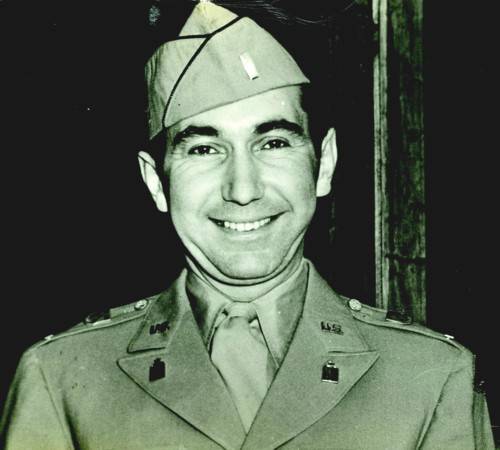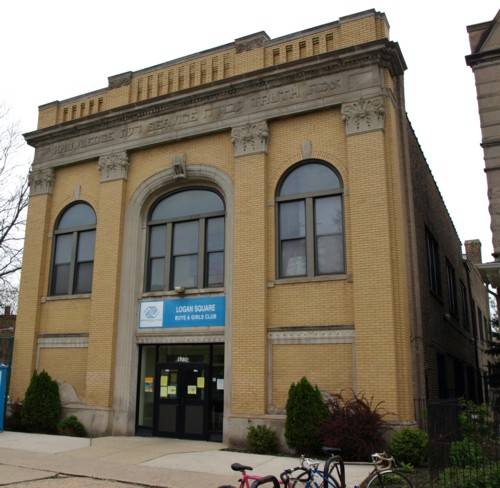Holding Steady During the '40s
Holding Steady During the 1940s
 Beth-El’s fortune had reversed in just eight years’ time. Dwindling and destitute in 1931, the temple prospered in 1939, reinvigorated with a broad mission, a growing membership, and the essential support of lay leaders like Nathan Joffe. Rabbi Lipman, however, did not stay with the temple to usher in the next decade, and resigned from his post in 1939.
Beth-El’s fortune had reversed in just eight years’ time. Dwindling and destitute in 1931, the temple prospered in 1939, reinvigorated with a broad mission, a growing membership, and the essential support of lay leaders like Nathan Joffe. Rabbi Lipman, however, did not stay with the temple to usher in the next decade, and resigned from his post in 1939.
Rabbi Lipman’s departure led to the opportunity to welcome Rabbi Paul Gorin, whose path to Palmer Square began with years of schooling in an Orthodox yeshiva, a degree from the University of Chicago, and then ordination at Hebrew Union College. Beth-El Congregation was Gorin’s first rabbinic appointment, and his years at the temple were extraordinarily productive for both the new rabbi and the almost 70-year-old congregation.
Paul Gorin’s rigorous education in both spiritual and secular matters provided him with a sensitivity and sharpness beyond his years that would serve him well at Beth-El. Rabbi Gorin was at ease at both ends of the religious spectrum; he was sympathetic to the ever-increasing trends of Midwestern Judaism toward the Reform movement and a strong advocate for traditional ritual practice both in and out of the synagogue. Congregants admired Rabbi Gorin for his good judgment, sensitivity, faith, community, and sense of duty to his synagogue and country.
 Duty to country was particularly important during Gorin’s rabbinate. Just 23 years after the end of World War I, the nation was once again under siege with the bombing of Pearl Harbor on December 7, 1941. Rabbi Gorin assumed a vital responsibility in the war effort. As a member of the U.S. Army Chaplaincy Corps, he was called to serve as a spiritual leader to Jewish troops in the Allied Forces in Europe. Rabbi Gorin departed for Harvard—the site of the U.S. Army Chaplaincy School—in early 1943, leaving Beth-El in the hands of Rabbi Joseph Strauss. Incidentally, Rabbi Strauss would go on to serve for many years as the head of Temple Menorah in West Rogers Park following his tenure at Beth-El.
Duty to country was particularly important during Gorin’s rabbinate. Just 23 years after the end of World War I, the nation was once again under siege with the bombing of Pearl Harbor on December 7, 1941. Rabbi Gorin assumed a vital responsibility in the war effort. As a member of the U.S. Army Chaplaincy Corps, he was called to serve as a spiritual leader to Jewish troops in the Allied Forces in Europe. Rabbi Gorin departed for Harvard—the site of the U.S. Army Chaplaincy School—in early 1943, leaving Beth-El in the hands of Rabbi Joseph Strauss. Incidentally, Rabbi Strauss would go on to serve for many years as the head of Temple Menorah in West Rogers Park following his tenure at Beth-El.
Between 1943 and 1946, the temple remained in a tenuous state; the congregation, like much of the country, was in flux. Nathan Joffe continued his leadership of the temple’s administration, and did much to sustain the temple financially. Rabbi Strauss provided the same support on the religious end, attempting to nourish a congregation beset with apprehension about the future.
Meanwhile, Rabbi Gorin distinguished himself abroad as a warm, wise, and judicious military officer. In 1944 and 1945, Gorin was stationed at an English base, and during his tour of duty there, he conducted regular Saturday-morning services at the West London Synagogue. On the High Holidays, Chaplain Gorin broadcast High Holiday services from the headquarters of his home base. Through Allied Forces Radio, Gorin’s songs and prayers reached servicemen across Europe for Rosh Hashanah and Yom Kippur.
Rabbi Gorin was also respected abroad for his eloquence. When the news of FDR’s death was announced to allied troops, he was one of several chaplains asked to deliver official eulogies at the ceremony. Gorin’s chaplaincy was also notable for his efforts to secure much-needed supplies and meals for Jewish servicemen stationed in areas where kosher food was not otherwise available. In collaboration with Chaplain Louis Milgrom of the Ninth Air Force, Gorin initiated a correspondence with Chief Rabbi Hertz of Great Britain. They established a supplies collection project, and the undertaking proved so successful that Milgrom and Gorin were able to send surplus goods to Munich.
Through the rabbis’ endeavors, Jewish servicemen across England and Germany received multiple shipments of canned goods, soap, winter clothing, used fur coats, condensed milk, and kosher food (including matzoh for Passover). These efforts did not go unnoticed—Chaplain Gorin was awarded a Bronze Star in September 1945 for his service.
In 1946, Gorin returned to the pulpit of Temple Beth-El in Logan Square, where he found a prospering synagogue, bursting with life but outgrowing its home. In the latter years of wartime, Jewish families had continued their migration toward the city’s periphery, saturating neighborhoods on the south and northwest sides. Logan Square received an influx of Jews, and many of these new families looked to Beth-El as their spiritual home.
In 1947, one family went even further, making the synagogue their permanent residence, and the temple community part of their extended family. The Marbell family arrived in Chicago after leaving Poland during the Nazi invasion and living in Siberia during the war. With almost nothing to their name, the Marbells had subsisted in Siberia for many months, enduring hardship after hardship. Yet their faith never wavered, even when their son Noah celebrated becoming a Bar Mitzvah in the Siberian woods. However, happier times awaited the family in Logan Square, where Morris Marbell became caretaker of the synagogue and Rivka Marbell became unofficial “bubbe” to every child in the congregation. The Marbells lived in the wooden house at Palmer Square, and it matched their character perfectly—humble, yet strong, weathered with time, close to God, and always filled with love.
During the following year, the Joffe Annex, dedicated by Nathan to honor his late daughter Adeline, was completed. The annex provided the temple with much-needed space for its expanding educational programs: six classrooms housed the Hebrew school, religious school, nursery school, and youth program.
The temple’s youth group was very popular in the late 1940s, and it would grow even more over the next 10 years to become the largest temple youth group in Chicago. Youth programming was an important pillar of Rabbi Gorin’s involvement with the synagogue, as were community and cultural outreach. Under his leadership, the temple’s presence within the Logan Square neighborhood developed. Aside from the booming youth group, the temple created a hugely popular dramatic troupe, partially led by congregant Rose Brown, which strengthened its sisterhood organization as well.
The latter years of the Gorin rabbinate were not without problems, however. By 1948, Rabbi Gorin had become aware of an issue that would soon affect, or was already affecting, members of the congregation with school-age children. Efforts by the city to redistrict Chicago’s outlying neighborhoods would culminate in a radical new geographical makeup that would divide many communities’ school districts in half. This impending shift in the public school demography made many families skittish about remaining in the neighborhoods near Beth-El. Rabbi Gorin addressed
their concerns by proposing to relocate the synagogue, but the temple administration was decidedly against it. The fallout of these negotiations chilled the rabbi’s relationship with the temple, and in 1949, Rabbi Gorin resigned, accepting a new pulpit in St. Louis.
Rabbi Joseph Buchler presided over Beth-El as the synagogue reached the middle of the century, but he would not remain with the congregation for long. Like his predecessor Paul Gorin, Rabbi Buchler made family the focus of his synagogue agenda. Under Buchler, the youth group, sisterhood, and religious school all continued to grow. During this time, Beth-El established Chicagoland’s first Jewish parents’ cooperative nursery. Although the temple became increasingly attractive to families with very young children, those with children already in school became more concerned with the looming troubles of public school redistricting.
Echoing Gorin’s efforts, Rabbi Buchler advocated for the relocation of the synagogue and was soundly rebuffed. Finding himself at odds with the temple board, Buchler vacated his post in 1954. He was succeeded by Victor H. Weissberg, one of the congregation’s greatest leaders and the man more responsible than any other for Beth-El’s continued prosperity through the 20th century.
Sat, October 25 2025
3 Cheshvan 5786
Quick Links
Email Us
Privacy Settings | Privacy Policy | Member Terms
©2025 All rights reserved. Find out more about ShulCloud



